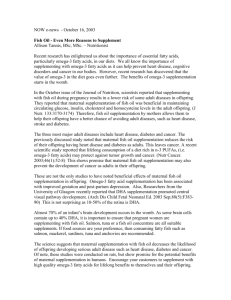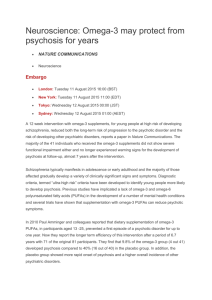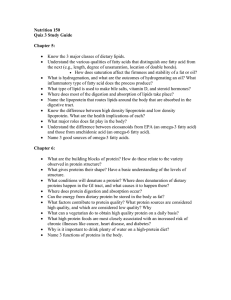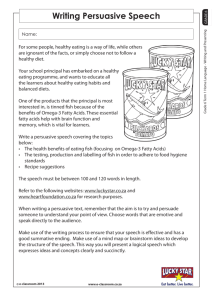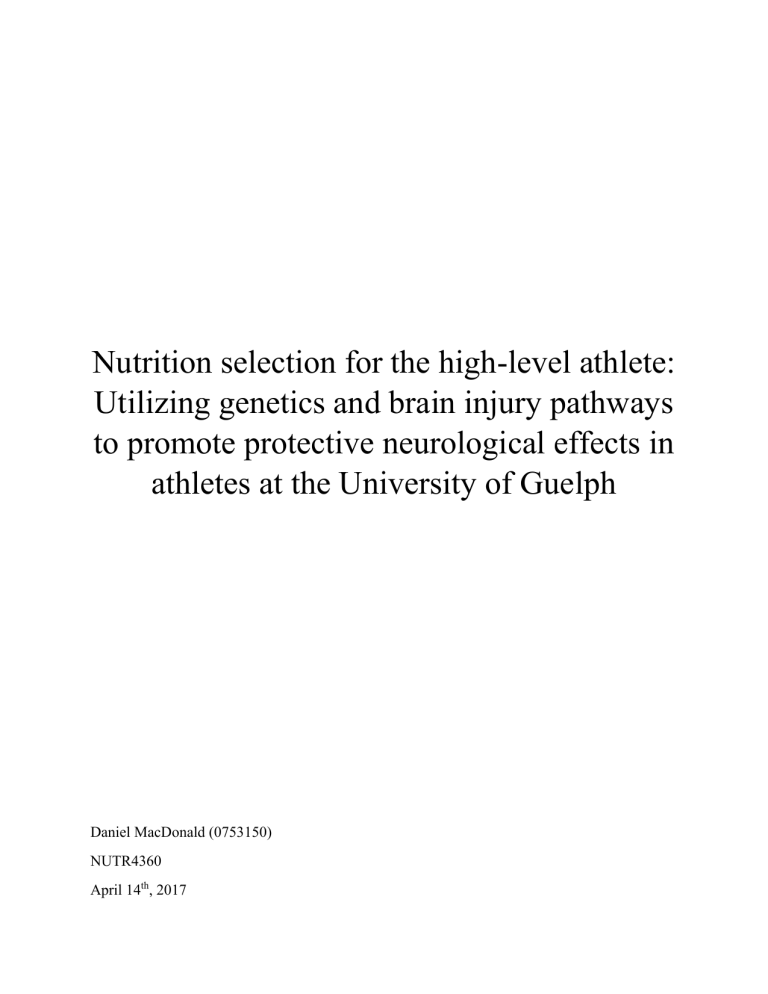
Nutrition selection for the high-level athlete: Utilizing genetics and brain injury pathways to promote protective neurological effects in athletes at the University of Guelph Daniel MacDonald (0753150) NUTR4360 April 14th, 2017 Introduction The future of sports, and the future of young athletes depends on finding a solution to the problem of concussions and its long-term impacts on health. In the past 10 years, Chronic Traumatic Encephalopathy (CTE) and its long-term health impacts on former athletes has become a major concern for parents and players of sport worldwide. Increased media coverage of concussion related deaths as well as increased reporting of injuries by former athletes is pushing parents and youth away from sports. The sports most associated with contact such as football and rugby are significantly impacted. Concussive and sub-concussive blows sustained during play have been linked to numerous instances of early onset Alzheimer’s disease, dementia, depression and death on a scale never before seen1. The rate of occurrence of these progressive injuries has been reported as high as 20-times greater than in an age matched population1. Chronic traumatic encephalopathy, or “punch drunk syndrome” is a progressive brain degenerative neurological condition that is characterized by the deposition of large quantities of paired helical filament tau proteins (PHF-tau) into large neurofibrillary tangles, neurophil neurites and astrocytic tangles1,2,6. This deposition mainly occurs in the brain in the frontal lobe, temporal lobe, basial ganglia and the brainstem as well as in the connective circuitry that link these sections of the brain6. This buildup of PHF-tau (specifically 3R and 4R variety) in these connections is associated with the progressive cognitive, mood and motor decline of CTE2,6. Furthermore, the increased presence of PHF-tau has been postulated to increase excess glutamate in the brain1,3,5,6. The extracellular glutamate (primary sources are microglia and astrocytes) lead to influx of massive quantities of calcium, which in turn leads to neuronal cell death through the production of ROS, increased oxidative stress, secretion of cytokines and other pro-inflammatory factors which promotes further glutamate cascading and in turn progressive neural degeneration1. These immunoexcitotoxic effects are characterized physiologically in the brain by the presence of cerebral and mammillary body atrophy, ventricular dilation in the first and third ventricle, decreased white matter integrity and cavum septum pellucidum (persistence of embryological fluid filled space in leaflets)4,6. In general, early symptoms of CTE present themselves through memory problems and confusion, depression, low behavioral control, increased agitation and aggression6,7. As the disease progresses, individuals may be subject to decreased cognitive abilities (speech, mood control), motor disturbances, Parkinsonism and dementia1,6. There is little known about the specific pathway for CTE development which indicates that preventative solutions are extremely scarce. There is an starting point for preventative research which includes the study of the correlation between CTE and the genes ApoE (specifically ApoE e4) and Transactive response DNA-binding protein 43 (TNP-43)1,6,7. Studies suggest that individuals with the ApoEe4 genotype are subject to more severe neurological outcomes in both early and late stages of life than the wild-type, as well as poorer recovery from TBIs as compared to the non-carriers1,6,7,8. Molecular analysis has shown a possible correlation between repeated TBI and increased toxicity of TDP-43, which is associated with frontotemporal dementia as well as ALS (amyotrophic lateral sclerosis). TDP-43 neurites, neuronal, glial and intranuclear inclusions present early in CTE9,10. As the disease progresses the TDP-43 immunoreactivity increases leading to increased accumulation of TDP-43 markers across the brain which include hippocampus, amygdala, cerebral cortex, medial temporal lobe, basal ganglia and the brainstem9,10. This increasing deposition and subsequent degeneration is associated with the behavior and personality changes seen in CTE9. Rationale In the U.S. alone there are between 1.6 and 3.8 million reported concussions annually, and CTE symptoms have been shown in individuals with singular instances of TBI, so there is a need for research and preventative solutions. Past studies in the analysis of traumatic brain injuries and omega 3 interactions have demonstrated in vivo and using animal models a strong correlation with protective and even regenerative properties. If we look at current published work by Bhardwaj, McMillan and Geser, TDP-43 autoregulation is controlled by TDBPR which is located in the 3’ coding region of TDP-4311,18,21. Autoregulation becomes unstable after concussive impact occurs, which leads miscoding in this region and subsequent mRNA instability11. Resulting overexpression of TDP-43 and the associated aggressive toxic effect seen in CTE patients. This excitotoxic effect was reduced in invitro models post concussive blows with the supplementation of Omega 311,13,14. Currently, research has already shown a link between Alzheimer’s disease and Eicospanetaenoic Acid (EPA) and Docosahexaenoic Acid (DHA) implementation, EPA models of protection is thought to occur through the inhibition of conversion of linoleic acid to arachondic acid (AA) limiting the rate production of inflammatory mediums such as prostaglandins, leukotrienes and thromboxanes16,17. DHA implementation is proposed to increase density of dendritic spines, synaptic proteins, and reduce amyloid-Beta plaque and reduce tau levels through reduce phosphorylation and conformational changes. DHA’s primary mechanism for neuroprotection has been correlated to increased its derivation of neuroprotectin D1(NDP1) which promotes membrane fluidity, regulates apoptosis and modulate inflammation and its mediators16,17. ApoE gene variation and n-3 Fatty acid interaction has been correlated with higher cognitive prevention against Alzheimers disease, dementia and general cognitive decline, which suggests a possible ApoE alleleotype interaction that affects effectiveness of supplementation and protective effects11,17. ApoEe4 variant is associate with increased risk of TBI degeneration, and n-3 FA supplementation may reduce risk of cognitive decline11,17. Furthermore, in-vivo studies suggest that post-injury Omega 3 consumption could serve to increases neurite density and length as compared to a control, which may indicate possible solutions for neurite death in CTE and other neurological disorders that have similar suggested pathways such as Alzheimer’s Disease and dementia15. The National Football League is the largest contact sports organization on the planet. The introduction of a possible solution to the most problematic health issue arising in the sport would be significant and would help to ensure the future of the league. As further research uncovers the problems associated with repetitive concussive blows, combined with our proposed Fatty Acid supplementation solution, the future for football across the globe remains viable and lucrative. In addition to finding the key to concussions, the link between cognitive degeneration and other neurological disorders such as Alzheimer’s and dementia could be solved through fatty acid supplementation. What is required is an organization willing to support fulsome high quality focused research Main Hypothesis and Objectives Due to current data suggesting a link between reducing neural degeneration in dementia patients with EPA and DHA supplementation, and considering the suggested CTE pathways that result in axonal and neuronal degeneration. It is hypothesized that the introduction of n-3 fatty acid supplementation pre-concussive blows may reduce the degree of cognitive injury. It is also suggested that in post-concussive states, Omega-3 fatty acid supplementation may help to stop further cognitive degeneration that is associated with CTE. Objective 1: To determine if Omega-3 supplementation is related to Fatty Acid levels in the midbrain in contact-sport athletes. In studies relying on the ingestion of Omega-3’s through fish consumption, 10 of 11 showed significant and non-significant protective effects11,28. In an elderly population group, individuals supplemented with DHA-EPA combination, 60% of the entire population showed improvement in cognitive functioning. In the non-dementia population, an increase of 75% was noted11,26. Studies analyzing a group of pre-dementia risk patients, found that DHA-EPA supplementation was critical with pre-dementia diagnosis in reducing extent of cognitive impairment11,26. Furthermore, the introduction of Omega-3 post-traumatic brain injury has been correlated with an increase in mitochondrial creatine kinase (uMtCK) that returns the enzyme to normal homeostatic levels13. This increase in uMtCK is responsible for maintaining calcium homeostasis and energy regulation of calcium pumps13. As stated previously, increased calcium influx into the brain results in neuronal cell death13. Methods Male contact-sport athletes with no prior head injuries from the University of Guelph will be selected participate in randomized controlled trial. The independent variable will be the supplementation of Omega-3 fatty acids, where half of participants will be randomly selected to receive a daily dosage of 1.5g of an EPA/DHA supplement in a ratio of 2:127. The other half of participants will receive a daily placebo, and will serve as the study control group. Supplementation will begin one month prior to the start of each participant’s sporting season, and discontinue once the season has concluded for a total duration of approximately five months. The dependent variable is midbrain fatty acid levels, which will be measured prior to the beginning of supplementation, and will then be re-measured post-sporting season for each participant. To measure midbrain fatty acid levels, a volumetric resolution MRI will be used. Fatty acid levels in the supplement group will be compared between the Omega-3 group and the placebo group. A two-tailed T-test will be used to determine if midbrain fatty acid levels are significantly greater in the Omega-3 group. Based on previous research conducted and reviewed by Huang, Contreras, Rapport and Mitchell et al, on the availability of Omega-3’s to pass into the midbrain through the blood brain barrier by way of protein and lipid transportation, it is anticipated that Omega-3 supplementation will increase fatty acid levels in the midbrain. With this study, issues that may arise pertain to the adherence of the athletes to consistently ingesting the Omega-3 supplements or placebos. This will be addressed through supervised administration. Additionally, other supplementation use (specifically with regards to antioxidants) will be suspended by participants in this study, as results could be altered by these substances. Athletes utilizing drugs that may increase cognitive performance, or alter chemical pathways significantly, such as anti-depressants or Adderall will not be admitted to the study. Objective 2: Determine the association between the presence of gene variants in TDP-43 associated proteins and ApoE genotypic variations and cognitive impairment due to concussive and sub-concussive blows and if Omega-3’s will mitigate cognitive impairment. As outlined in the introduction to our research, there is a clear association between the autoregulation of TNP-43 and cognitive decline. The microtubule-associated protein tau (MAPT) gene, tags with a H1 and H2 haplotype18,22. H1 haplotype is correlated with 4 different taupathic pathways and the A/A form is protective of atrophy as compared to H2 allele carriers. H2 is associated with reduced brain weight, reduced glucose metabolism and increased neurofibrillary tangles18,22. Previous studies propose that the H1 haplotype correlates with increased risk of tauopathies, and in turn H2 is correlated with in increased Temporal degeneration from TDP-43 excitooxicity18,22. Sortilin related gene variants (rs646776) was correlated to have a 2-fold increase in risk for TDP-43 pathology relating to tauopathy18. This correlation is presumed to occur due to reduced Fatty acid levels in the midbrain as well as decrease in progranulin levels that correlate with increased accumulation of neutrophils and inflammatory factors (McMillan, He). Granulin Precursor variation (rs5848) correlated to 3.2 times risk increase in TDP-related neuron degeneration18, and also correlates with reduced FA. GRN associated mutations have been correlated with myelin changes, microglial activation and gliola (neuronal loss) especially in the midbrain18,20,21. It is hypothesized that individuals that carry SNP variants in the Granular Precusor (GNP) gene (rs5848), Soritilin (SORT1) variant rs646776 and Microtubule-associated protein tau (MAPT) and its risk conferring allele A/A gene (rs8070723) will correlate to higher incidences of tau-related neuronal degeneration and subsequently higher incidences of CTE related cognitive decline11,18,20. Individuals carrying the apolipoprotein E gene (ApoE) variant epsilon 4 has been associated with increased susceptibility16,29. Individuals that carry the ApoEe4 genotype have been suggested to be incompatible with the protective affects of Omega-3 supplementation against TBI and its related effects, which has been associated with decreased FA transport across the blood brain barrier16,29,30. Additionally, DHA supplementation may have atherogenic affects in individuals with ApoEe4, as an increase in LDL cholesterol was associated with the gene variant post-supplementation16,25. Methods Male contact-sport athletes with no prior head injuries from the University of Guelph will be selected participate in randomized controlled trial. The independent variable will be the supplementation of Omega-3 fatty acids, where half of participants will be randomly selected to receive a daily dosage of 1.5g of an EPA/DHA supplement in a ratio of 2:127. The other half of participants will receive a daily placebo, and will serve as the study control. Supplementation will begin one month prior to the start of each participant’s sporting season, and discontinue once the season has concluded for a total duration of approximately five months. Only participants sustaining concussive or sub-concussive blows, tracked using a JOLT sensor31, will be included in this study. The dependent variable will be the presence of gene variants in the TDP-43 associated genes SORT1 (rs646776), GNP (rs5848), MAPT (rs8070723) as well at ApoE genome variant episolon-4. MassARRAY Assay design software will be used to assess the presence of gene variants according to methods outlined by McMillan et al18. The presence of gene variants will be compared between the Omega-3 group and the placebo group to determine if omega-3 supplementation mitigates cognitive impairment in athletes with concussive or subconcussive blows. A t-tailed t-test will be used to determine the presence of a significant effect. Based on previous research outlined in the McMillan, Wider and Gass studies have demonstrated that cognitive impairment after the introduction of Omega-3 supplementation in individuals with these gene variants will be reduced18,20,22. The issues that may affect results are adherence to supplementation, which will be addressed through supervised administration. Additionally, other supplementation use (specifically with regards to antioxidants) will be suspended by participants in this study, as results could be altered by these substances. Athletes utilizing drugs that may increase cognitive performance, or alter chemical pathways significantly, such as antidepressants or Adderall will not be admitted to the study Conclusion In conclusion, current data and previous studies suggest that the implementation of Omega-3 supplements in pre and post traumatic brain injury states may experience improved cognitive protection and quicker recovery post injury. The introduction of Omega-3 supplements are proposed to increase fatty acid levels across the brain (in this case study, specifically in the midbrain). The association between Omega-3 supplementation and gene variants associated with TDP-43 and ApoE, with regards to concussive and sub-concussive blows, is proposed to demonstrate significant preventative effects on in individuals carrying these gene variants. The expected outcomes of the trials suggest that the link between EPA and DHA supplementation will result in greater protection pre and post concussive episodes. The genotypic variation of TDP-43 and ApoE that codes to greater cognitive impairment post TBI episodes will offer greater protection and recovery than the control group. The potential outcomes of this study will provide an approach to assist in the reduction in the number of current and former football players that suffer from CTE and other dementia related diseases. The supplementation of EPA and DHA in younger high-collision sport athletes should reduce the intensity of concussive episodes, which may enable a quicker return to play and reduced negative long-term health effects. Additionally, further studies of Omega-3 supplementation in related dementia and neurocognitive impairment illnesses such as Alzheimer’s and ALS may produce a viable option for reduced cognitive impairment and decline in susceptible individuals References 1. 2. 3. 4. 5. 6. 7. 8. 9. 10. 11. 12. 13. 14. 15. 16. 17. 18. 19. 20. 21. 22. Yi Juneyoung MD, P. D. J. M., Chin Lawrence S. MD, Montenegro Philip BS, Cantu Robert C. MD. (2013) Chronic Traumatic Encephalopathy Current Sports Medicine Reports 12, 28-32 Jorge R. Barrio, G. W. S., Koon-Pong Wong, Sung-Cheng Huang, Jue Liu, David A Merrill, Christopher C Giza, Robert P Fitzsimmons, Bennet Omalu, Julian Bailes, Vladamir Kepe. (2015) In vivo characterization of chronic traumatic encephalopathy using [F18]FDDNP PET brain imaging Proceedings of the National Academy of Sciences 112, E2039-E2047 B, O. (2014) Concussion. Progressive Neurological Surgery 28, 38-49 Jordan, B. (2015) Chromic traumatic encephalopathy. Journal of the Neurological Sciences 357, e502 G.Sharpe, J. W. O. a. L. (1969) Brain Lesions in an Infant Rhesus Monkey Treated with Monosodium Glutamate Science 166, 386-388 Meehan, W. I. M. M., Rebekah MD, MPH; Zafonte, Ross MD; Pascual-Leone, Alvaro MD, PHD. (2015) Chronic traumatic encephalopathy and athletes. Neurology 85, 1504-1511 Jordan, B. D. (2000) Chronic Traumatic Brain Injury Associated with Boxing. Seminars in Neurology 20, 179186 Kutner KC, E. D., Tsai J, Jordan B, Relkin NR. (2000) Lower cognitive performance of older football players possessing apoliprotein E epsilon 4. Neurosurgery 47, 651-657 Ann C McKee, T. D. S., Christopher J Nowinski, Robert A Stern, Daniel H Daneshvar, Victor E Alvarez, HyoSoon Lee, Garth Hall, Sydney M Wojtowicz, Christine M Baugh (2013) The spectrum of disease in chronic traumatic encephalopathy. Brain 136 Christine M Baugh, J. M. S., David O Riley, Brandon E.Gavett, Martha E. Shenton, Alexander Lin, Christopher J. Nowinski, Robert C. Cantu, Ann C. Mckee, Robert A. Stern. (2012) Chronic traumatic encephalopathy: neurodegeneration following repetitive concussive and subconcussive brain trauma. Brain Imaging and Behavior 6, 244-254 Amit Bhardwaj, M. P. M., Emanuele Buratti, Francisco E. Baralle (2013) Characterizing TDP-43 interaction with its RNA targets Nucleic Acids Research 41, 5062-5074 Erdman J, O. M., Pillsbury L. (2011) Nutrition and Traumatic Brain Injury: Improving Acute and Subacute Health Outcomes in Military Personnel. National Academies Press 13, nbk209320 Wu A, Y. Z., Gomez-Pinilla F. (2007) Omega-3 fatty acid supplementation restores mechanisms that maintain brain homeostasis in traumatic brain injury. Journal of Neurotrauma 24, 1587-1595 Michael-Titus, A. T. (2009) Omega-3 fatty acids: their neuroprotective and regenerative potential in traumatic neurological injury. Clincial Lipidology 4, 343 Frances Calderon, H.-Y. K. (2004) Docosahexaenoic acid promotes neurite growth in hippocampal neurons. Journal of Neurochemistry 90, 979-988 Huang, T. L. (2010) Omega-3 Fatty Acids, Cognitive Decline, and Alzheimer's Disease: A Critical Review and Evaluation of Literature. Journal of Alzheimer's Disease 21, 673-690 PD Leclercq, L. M., C Smith, DI Graham, JAR Nicoll, SM Gentleman. (2005) Cerebral amyloid angiopathy in traumatic brain injury: association with apiloprotein E genotype Journal of Neurology, Neurosurgery & Psychiatry 76, 229-233 Corey T McMillan, J. B. T., Brian B Avants, Philip A Cook, Elisabeth M Wood, Eunran Suh, David J Iwin, John Powers, Christopher Olm, Lauren Elman, Leo McCluskey. (2014) Genetic and neuroanatomic associations in sporadic frontotemporal lobar degeneration. Neurobiology of Aging 35, 1473-1482 He Z, O. C., Halper J, Bateman A. (2003) Progranulin is a mediator of the wound response Nature Medicine 9, 225-229 Jennifer Gass, A. C., Bradley Boeve, Matt Baker, Jennifer Adamson, et al. (2006) Mutations in progranulin are a major cause of ubiquitin-postive frontotemporal lobar degeneration. Human Molecular Genetics 15, 29883001 Geser F, M.-L. M., Robinson J, Uryu K, Neumann M, Brandmeir N, et al. (2009) Clinical and pathological continuum of multisystem TDP-43 proteinopathies. Archives of Nuerology 66, 180-189 Wider C, R. O., Nishioka K, Heckman MG, Vilarino-Guell C, Jasinska-Myga B, Erketin-Taner N, et al. (2012) An evaluation of the impact of MAPT, SNCA and APOE on the burden of Alzheimer's and Lewy Body Pathology. Journal of Neurology, Neurosurgery & Psychiatry 83, 424-429 23. MA Contreras, S. R. (2002) Recent studies on interactions between n-3 and n-6 polyunsaturated fatty acids in brain and other tissues. Current Opinions in Lipidology 13, 267-272 24. Ryan W Mitchell, N. H. O., Marc R Del Bigio, Donald W Miller, Grant M Hatch. (2011) Fatty acid transport protein expression in human brain and potential role in fatty acid transport across human brain microvessel endothelial cells. Journal of Neurochemistry 117, 735-746 25. E Olano-Martin, E. A., MJ Caslake, CJ Packard, D Bedford, G Stewart, D Peiris, CM Williams, Am Minihane. (2009) Contribution of apiloprotein E genotype and docosahexaenoic acid to the LDL-cholesterol response to fish oil. Atherosclerosis 209, 104-110 26. H Suzuki, Y. M., Takahashi H. (2001) Effect of DHA oil supplementation on intelligence and visual acuity in the elderly World Review of Nutrition and Dietetics 88, 68-71 27. Mickleborough, T. D. (2013) Omega-3 Polyunsaturated Fatty Acids in Physical Performance Optimization. International Journal of Sports Nutrition and Excersize Metabolism 23, 83-96 28. BM van Gelder, M. T., S Kalmijn, D Kromhout (2007) Fish Consumption, n-3 fatty acids, and subsequent 5-y cognitive decline in elderly men: The Zutphen Elderly Study. American Journal of Clinical Nutrition 85, 11421147 29. SI Rapoport, M. C., AA Spector (2001) Delivery and turnover of plasma-derived essential PUFAs in mammalian brain. Journal of Lipid Research 42, 678-685 30. LJ Whalley, I. D., JM Starr, KW Wahle, KA Rance, VJ Bourne, HC Fox. (2008) n-3 Fatty acid erythrocyte membrane content, APOE epsilon4 and cognitive variation: an observational follow up study in late adulthood. American Journal of Clinical Nutrition 87, 449-454 31. Jolt Athletics, I. (2017) Jolt Sensor http://www.joltsensor.com/
